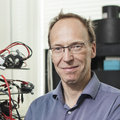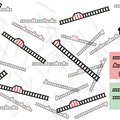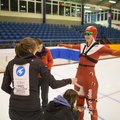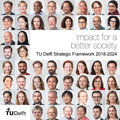Latest News
23 February 2018
Marnix Wagemaker receives Vici for battery research

Dr. ir. Marnix Wagemaker will receive a Vici grant from NWO. Wagemaker is getting this grant, which amounts to 1.5 million euros, to investigate the inner workings of batteries. Among other things, the researcher aims to find out why the storage capacity achieved by the current generation of batteries is lagging behind that which should theoretically be feasible. An additional 250.000 euros of in-kind contributions will be provided by companies that are involved in the research.
22 February 2018
Loops, loops, and more loops: This is how your DNA gets organised

Researchers from the Kavli Institute of Delft University and EMBL Heidelberg now managed for the first time to isolate and film and witnessed—in real time—how a single protein complex called condensin reels in DNA to extrude a loop.
15 February 2018
Programming on a silicon quantum chip
Quantum technology makes a great leap forward. While scientists can control a few qubits with great reliability, it doesn’t yet look like a real computer. Useful quantum chips require programmability: the ability to perform an arbitrary set of operations. Scientists from QuTech in Delft have now realised a programmable two-qubit quantum processor in silicon successfully implementing two quantum algorithms. They have published their work in the magazine Nature.
12 February 2018
Designing and testing medical instruments without expensive prototypes
Complex new medical instruments often do not make it beyond the expensive and time-consuming prototype phase. With this in mind, Ewout Arkenbout developed a new, virtual development method allowing for instruments to be evaluated and adjusted at an earlier stage. On Monday 12 February, Arkenbout will be awarded his PhD at TU Delft for his work on this subject.
07 February 2018
Mathematics explains why Crispr-Cas9 sometimes cuts the wrong DNA

The discovery of the Cas9 protein has been of great value to medical science. It has simplified gene editing tremendously, and may even make it possible to eliminate many hereditary diseases in the near future. Using Cas9, researchers have the ability to cut DNA in a cell to correct mutated genes, or paste new pieces of genetic material into the newly opened spot. Initially, the Crispr-Cas9 system seemed to be extremely accurate. But unfortunately, it is now apparent that Cas9 sometimes also cuts other DNA sequences similar to the exact sequences it was programmed to target. Scientists at Delft University of Technology have developed a mathematical model that explains why Cas9 cuts some DNA sequences while leaving others alone.
05 February 2018
The quest to find the optimal speed skating technique

In her search to determine the optimal speed skating technique, doctoral candidate Eline van der Kruk developed a dynamic computer model of a skater and instrumented clap skates. In the future, these will make it possible to offer skaters and coaches real-time visual feedback during training sessions. On Thursday 8 February, the day before the start of the Winter Olympics, Van der Kruk will be awarded her PhD at TU Delft for her work on this subject.
01 February 2018
Clive Brown of Oxford Nanopore at Bioengineering Institute kickoff
On Tuesday 27 March, TU Delft will launch the Delft Bioengineering Institute. Main speaker is Clive Brown, Chief Technology Officer at DNA sequencing specialist Oxford Nanopore Technologies.
01 February 2018
Impact for a better society: TU Delft Strategic Framework 2018-2024

On 12 January, during the 176th Dies Natalis, the new strategic plan for TU Delft was presented, the Strategic Framework 2018-2024.
31 January 2018
Dutch drone first to map pristine national park in half a century

ATMOS UAV, a start-up company from the faculty of Aerospace Engineering, announced on 31 January that their drone Marlyn was used to chart the tropical island of Silhouette in the Seychelles in the Indian Ocean.
30 January 2018
Fiery romance: a risk-model for sky lanterns

This week it’s Valentine’s Day as well as Chinese New Year. A popular week for flying sky lanterns. How safe are they and how do you make a risk-model for them? Michiel Schuurman and Derek Gransden looked into it.
